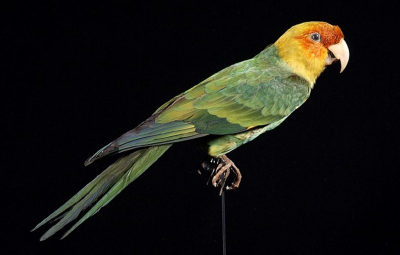The Cincinnati Zoo & Botanical Garden is the second oldest zoo in the United States, founded in 1873 and officially opening in 1875, after the Roger Williams Park Zoo (1872). It is located in the Avondale neighborhood of Cincinnati, Ohio. It originally began with 64.5 acres (26.1 ha) in the middle of the city, but has spread into the neighboring blocks and several reserves in Cincinnati's outer suburbs. It was appointed as a National Historic Landmark in 1987.The zoo houses over 500 animals and 3,000 plant species. In addition, the zoo also has conducted several breeding programs in its history, and was the first to successfully breed California sea lions. In 1986, the Lindner Center for Conservation and Research of Endangered Wildlife (CREW) was created to further the zoo's goal of conservation. The zoo is known for being the home of Martha, the last living passenger pigeon, and to Incas, the last living Carolina parakeet.The zoo is an accredited member of the Association of Zoos and Aquariums (AZA), and a member of the World Association of Zoos and Aquariums (WAZA).A 2014 ranking of the nations's best zoos by USA Today based on data provided by the Association of Zoos and Aquariums lists the Cincinnati Zoo among the best in the country. A 2019 reader's choice ranking of the nation's best zoos by USA Today named the Cincinnati Zoo the top zoo in North America.
The Carolina parakeet (Conuropsis carolinensis), or Carolina conure, is an extinct species of small green neotropical parrot with a bright yellow head, reddish orange face and pale beak that was native to the eastern, Midwest and plains states of the United States. It was the only indigenous parrot within its range, as well as one of only three parrot species native to the United States (the others being the thick-billed parrot, now extirpated, and the green parakeet, still present in Texas; a fourth parrot species, the red-crowned amazon, is debated). The Carolina parakeet was found from southern New York and Wisconsin to Kentucky, Tennessee and the Gulf of Mexico, from the Atlantic seaboard to as far west as eastern Colorado. It lived in old-growth forests along rivers and in swamps. It was called puzzi la née ("head of yellow") or pot pot chee by the Seminole and kelinky in Chickasaw. Though formerly prevalent within its range, the bird had become rare by the middle of the 19th century. The last confirmed sighting in the wild was of the ludovicianus subspecies in 1910. The last known specimen perished in captivity at the Cincinnati Zoo in 1918 and the species was declared extinct in 1939.
The earliest reference to these parrots was in 1583 in Florida reported by Sir George Peckham in A True Report of the Late Discoveries of the Newfound Lands of expeditions conducted by English explorer Sir Humphrey Gilbert who notes that explorers in North America "doe testifie that they have found in those countryes; ... parrots." They were first scientifically described in English naturalist Mark Catesby's two volume Natural History of Carolina, Florida and the Bahama Islands published in London in 1731 and 1743.
Carolina parakeets were probably poisonous—American naturalist and painter John J. Audubon noted that cats apparently died from eating them, and they are known to have eaten the toxic seeds of cockleburs.

1918Feb, 21
The last Carolina parakeet dies in captivity at the Cincinnati Zoo.
Choose Another Date
Events on 1918
- 3Mar
World War I
Russia signs the Treaty of Brest-Litovsk, agreeing to withdraw from World War I, and conceding German control of the Baltic States, Belarus and Ukraine. It also conceded Turkish control of Ardahan, Kars and Batumi. - 2May
Chevrolet Motor Company
General Motors acquires the Chevrolet Motor Company of Delaware. - 24Jun
Montreal
First airmail service in Canada from Montreal to Toronto. - 4Jul
Nicholas II of Russia
Bolsheviks kill Tsar Nicholas II of Russia and his family (Julian calendar date). - 9Nov
Wilhelm II, German Emperor
Kaiser Wilhelm II of Germany abdicates after the German Revolution, and Germany is proclaimed a Republic.

 English
English  español
español  français
français  português
português  русский
русский  العربية
العربية  简体中文
简体中文 